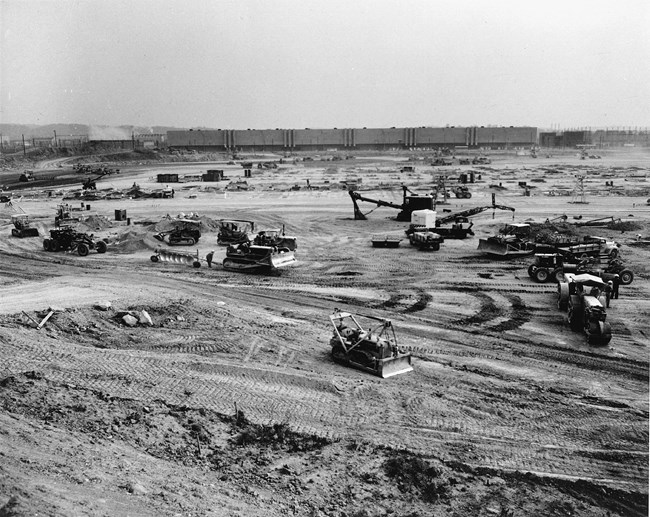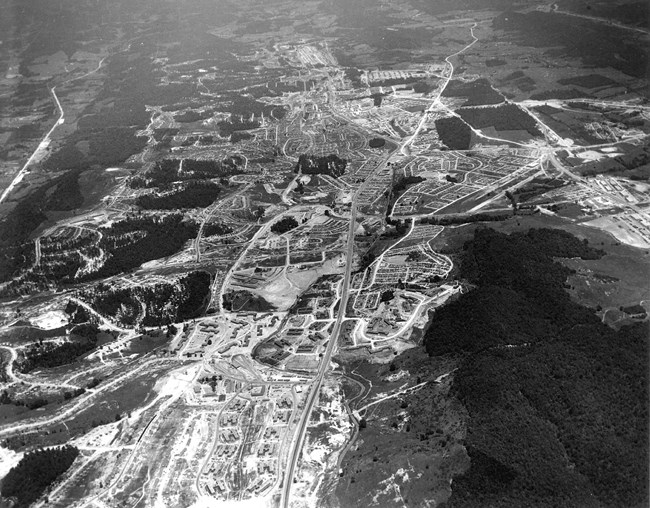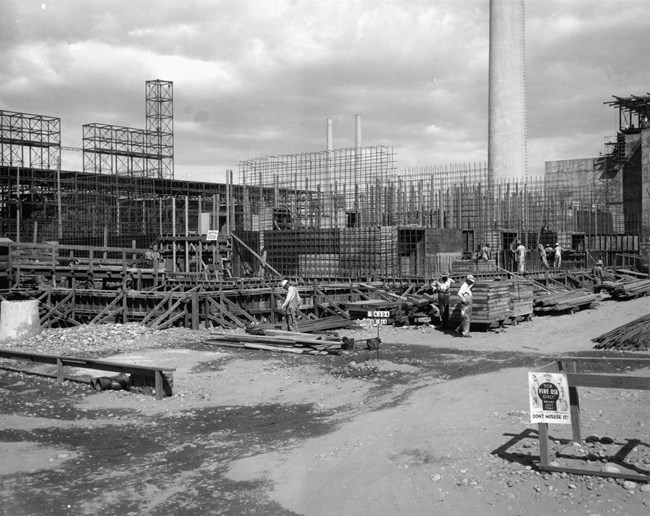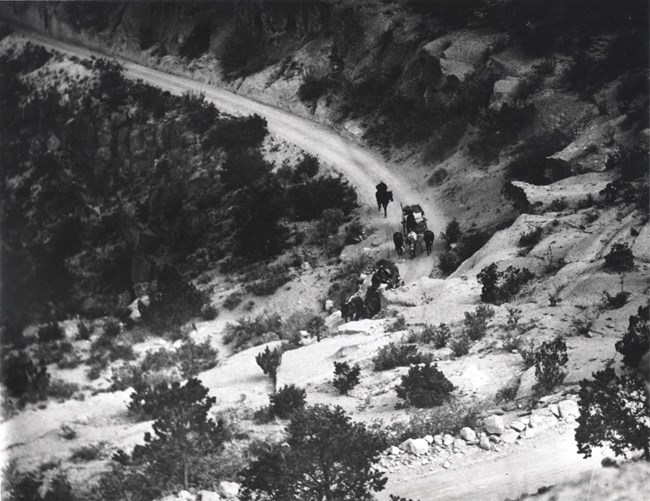Last updated: April 5, 2023
Article
Manhattan Project Site Selection
On December 21, 1938, German scientists Otto Hahn and Fritz Strassman became the first people to successfully split, or fission, a uranium atom. This groundbreaking experiment sent shockwaves throughout the scientific community. Word rapidly reached the United States and European allies that Nazi Germany was on a possible path to developing atomic weapons. On August 2, 1939, at the urging of scientist Leo Szilard, physicist Albert Einstein sent a letter to US President Franklin Roosevelt warning him that Nazi Germany may already be developing this strange and powerful new weapon. As a result, Roosevelt established the Advisory Committee on Uranium in 1939. In the spring of 1941, several British scientists implored Roosevelt to initiate development of an atomic weapons program in the United States, hoping to beat Nazi Germany in the race to develop this new technology.
Several delays in mobilization prevented the Manhattan Project from moving forward. In September, 1942 United States Army General Leslie R. Groves was assigned to manage the Manhattan Project. He acquired funding, mobilized a diverse workforce including attracting top scientists, and selected the ideal locations for the Project to ensure secrecy and success in this new, dramatic undertaking. Ultimately, Groves approved three locations for this new clandestine project: Oak Ridge, Tennessee, Hanford, Washington, and Los Alamos, New Mexico. These locations were not chosen at random; each had to meet special requirements for the Manhattan Project to ultimately succeed.
Several delays in mobilization prevented the Manhattan Project from moving forward. In September, 1942 United States Army General Leslie R. Groves was assigned to manage the Manhattan Project. He acquired funding, mobilized a diverse workforce including attracting top scientists, and selected the ideal locations for the Project to ensure secrecy and success in this new, dramatic undertaking. Ultimately, Groves approved three locations for this new clandestine project: Oak Ridge, Tennessee, Hanford, Washington, and Los Alamos, New Mexico. These locations were not chosen at random; each had to meet special requirements for the Manhattan Project to ultimately succeed.

US DEPARTMENT OF ENERGY
Oak Ridge, Tennessee
On September 19, 1942, two days after being assigned the lead role in developing the Manhattan Project, General Groves approved an idyllic location in East Tennessee, a series of valleys and rolling hills approximately twenty miles west of Knoxville. With the Appalachian mountains to the east and the Cumberland Plateau to the west, this sparsely populated area proved to be an ideal choice to develop what would eventually become Oak Ridge. At the time of selection, Oak Ridge was named the Kingston Demolition Range and later the Clinton Engineer Works. Oak Ridge was slated to hold four production plants: gaseous diffusion, pile, centrifuge, and electromagnetic. Prior to selecting this site, General Groves’ team scouted several locations throughout the US. Chicago was considered but was deemed too densely populated for the scale of development required. California was also scouted but was too close to the coast and therefore too vulnerable to potential enemy attack. Lastly, several sites in Washington state were considered but too much work was required to install power lines for the immense energy needed and, like California, it was considered vulnerable to potential attack.
US DEPARTMENT OF ENERGY
During the fall of 1942, land acquisition began with the purchase of over 55,000 acres at a cost of approximately $3.5 million in 1942 dollars. By spring of 1943 the site was officially designated Clinton Engineer Works, and in the fall of that year, construction had begun on a massive building for enriching uranium. The need for construction workers at this new gaseous diffusion plant, named K-25, and other uranium enrichment facilities in the city caused the population of Oak Ridge to increase from 13,000 people as originally planned to over 75,000 by the end of the war. At its peak, K-25 employed 12,000 workers and was one of the linchpins of what would become the most populous Manhattan Project site in the country.

US DEPARTMENT OF ENERGY
Hanford, Washington
While the Clinton Engineer Works (Oak Ridge) was developed by Groves and his team to enrich uranium, a site also had to be found to produce plutonium. With Knoxville, Tennessee being so close to Oak Ridge, Groves ruled out the addition of a plutonium production nuclear reactor in the region. A potential failure of a reactor could have dire consequences for the population of the nearby city. Once again, Groves turned to Washington state as an option.Any potential plutonium production site required three things: water, power, and a large area with few people. The Pacific Northwest met the criteria. The large and fast-moving Columbia River could provide water for cooling the reactors, and the Grand Coulee Dam on the Columbia could provide the hydroelectric power needed. The lightly populated open expanse of south eastern Washington could provide the space to ensure safe and efficient operation. In January of 1943, after having personally visited the site, General Groves acquired 780 square miles of land along the Columbia at at cost of $5.1 million in 1943 dollars. With sufficient hydroelectric dams and power lines, the Hanford Engineer Works began construction, so named because of a tiny village of less than 100 residents located within the plot of land. The Manhattan Project now had an ideal location for plutonium production. By October 1943, construction of Hanford's B Reactor had begun.

US DEPARTMENT OF ENERGY
Los Alamos, New Mexico
By 1944, the Clinton Engineer Works in East Tennessee and the Hanford Engineer Works in Washington State were well on their way to producing enriched uranium and plutonium, respectively. And by that time, on an isolated mesa top in New Mexico, world-renowned scientists, led by J. Robert Oppenheimer, were hard at work developing designs for the atomic bombs.The search for a site to house the weapons design and research facilities took a few twists and turns before settling on the isolated mesa top. Groves’ subordinate, Major John H. Dudley, was tasked with finding a remote location west of the Mississipppi River that was a minimum of two hundred miles from an international border and had ample outdoor space for testing and room for 265 residents. Dudley initially proposed Oak City, Utah, a small desert community that fit the requirements. However, this site would demand the removal of a large swath of productive farmland as well as several families. Dudley set his sights farther south.
Along with Oppenheimer, Dudley next scouted Jemez Springs, New Mexico, a narrow canyon about 40 miles north of Santa Fe. Oppenheimer objected to the confines of a canyon and proposed to Dudley a location on a mesa above the canyon that was home to the Los Alamos Ranch School, a boarding school for boys operated by Ashley Pond. This proved to be an ideal location: isolated with ample space for housing, research, and testing. It also had a panoramic view that Oppenheimer desired. Ashley Pond was willing to sell. On November 25th, 1942, the War Department approved the purchase of the Los Alamos Ranch School for $440,000 in 1942 dollars.
At 5:30 am Mountain War Time on July 16, 1945, after lengthy development, the world’s first atomic test device, codenamed Trinity, exploded in New Mexico’s Tularosa Basin, ushering in the Atomic Age. On August 6 and 9, 1945, the US dropped atomic bombs on Hiroshima and Nagasaki Japan. Imperial Japan announced their surrender on August 15, 1945 and formally signed on September 2, 1945 bringing World War II to an end. Although the three sites chosen for the Manhattan Project were quite different in terms of geography, population, and purpose, successful development of the world's first atomic weapons could not have been achieved without all three working together.
- Johnson, Charles W., and Charles O. Jackson. City Behind a Fence: Oak Ridge, Tennessee 1942-1946. Knoxville: The University of Tennessee Press, 1981.
- Kelly, Cynthia C., ed., The Manhattan Project. New York: Black Dog & Leventhal Publishers, 2007.
- Rhodes, Richard. The Making of the Atomic Bomb. New York: Simon and Schuster Paperbacks, 1986.
